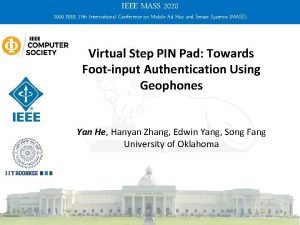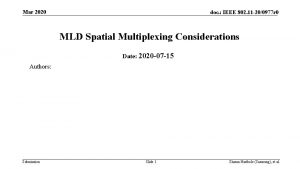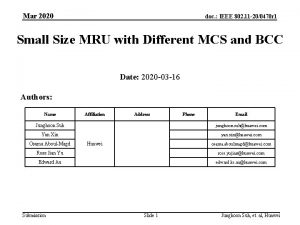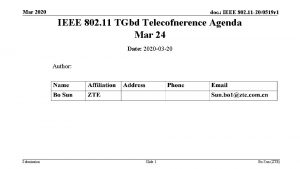Mar 2020 doc IEEE 802 11 200370 r









![Mar 2020 doc. : IEEE 802. 11 -20/0370 r 0 References [1] 11 -19 Mar 2020 doc. : IEEE 802. 11 -20/0370 r 0 References [1] 11 -19](https://slidetodoc.com/presentation_image_h2/8fdd3923f07d57b04b074a1ceb9137aa/image-10.jpg)

- Slides: 11

Mar 2020 doc. : IEEE 802. 11 -20/0370 r 0 Multi-link Power Save Discussion Date: 2020 -03 -15 Authors: Submission Slide 1 Sharan Naribole (Samsung), et al.

Mar 2020 doc. : IEEE 802. 11 -20/0370 r 0 Introduction • Multi-link operation (MLO) is a key feature of the 802. 11 be standard development • Power save is an important topic of MLO • In this contribution, we review multi-link power saving and present extreme low power multi-link operating mode Submission Slide 2 Sharan Naribole (Samsung), et al.

Mar 2020 doc. : IEEE 802. 11 -20/0370 r 0 Multi-link Power Save – Motions Recap • Each non-AP STA affiliated with a non-AP MLD that is operating on an enabled link maintains its own power state/mode. • An AP of an AP MLD may transmit on a link a frame that carries an indication of buffered data for transmission on other enabled link(s) • A non-AP MLD monitors and performs basic operations (such as traffic indication, BSS parameter updates, etc. ) on one or more link(s). Submission Slide 3 Sharan Naribole (Samsung), et al.

Mar 2020 doc. : IEEE 802. 11 -20/0370 r 0 Multi-link Power Saving • Enabling multiple links and running power save mode independently on each link might not be the preferred multi-link power save operation • In some implementations, even when a single link is in awake state, the upper MAC needs to be turned on • In worst case, the power saving might be negligible if the sleep cycles are unsynchronized • However, synchronizing power saving mechanisms e. g. TWT over multiple links introduces additional complexity at the AP MLD as tighter synchronization is required in multi-link BSS management • Therefore, for a non-AP MLD, a practical power save mode is to enable only a single link and activate power saving mode on that link. Submission Slide 4 Sharan Naribole (Samsung), et al.

Mar 2020 doc. : IEEE 802. 11 -20/0370 r 0 Extreme Low Power Multi-link Operation mode • We propose extreme low power multi-link operation mode as the 802. 11 be non-AP MLD operating mode in which the non-AP MLD enables a single link among the setup links and the non-AP MLD runs power save mechanism(s) on that link. o Exact name of this mode is TBD • We denote this enabled link as Anchor link and it is in reference to a non-AP MLD • Option 1: Fixed Anchor link o Negotiated during multi-link setup o Option 2: Dynamic Anchor link o Dynamically selected by non-AP MLD and not selected a priori o AP MLD can provide recommendations • AP MLD includes info of basic operation (such as traffic indication, BSS parameter updates, etc. ) of all setup links to a non-AP MLD on the anchor link o Beacons/Probe Responses on anchor link provide other links’ info for this non-AP MLD on anchor link o Mechanisms to avoid Beacon bloating presented in [3] Submission Slide 5 Sharan Naribole (Samsung), et al.

Mar 2020 doc. : IEEE 802. 11 -20/0370 r 0 Switching to/from Extreme Low Power MLO Mode • We propose 802. 11 be shall define fast transition mechanism (e. g. Switch frame) for a non. AP MLD to switch to and from the extreme low-power multi-link operation mode. o In contrast to sending per-link enable/disable messages and power save mode indication • Switching to extreme low power MLO mode o Switch frame by non-AP MLD can be transmitted on any enabled link o Switch frame shall include the Anchor link identifier if the switch frame transmitted on another link o TID-to-link mapping is updated to all TIDs mapped to the anchor link • Switching out of extreme low power MLO mode o Option 1: TID-to-link mapping is updated to the mapping prior to switching into extreme low power MLO mode o Option 2: Non-AP MLD explicitly indicates the TID-to-link mapping in the message for switching out of extreme low power MLO mode Submission Slide 6 Sharan Naribole (Samsung), et al.

Mar 2020 doc. : IEEE 802. 11 -20/0370 r 0 Summary • Enabling only a single link and activating power save mechanisms is a practical MLO power save mode • Require efficient fast transition mechanism for switching to and from extreme low power MLO mode • Anchor link can be fixedat multi-link setup or dynamically selected by non-AP MLD including recommendations from AP MLD Submission Slide 7 Sharan Naribole (Samsung), et al.

Mar 2020 doc. : IEEE 802. 11 -20/0370 r 0 Straw Poll #1 • Do you support that 802. 11 be shall define an extreme low power multi-link operation mode for non-AP MLDs? o Exact name of the mode is TBD o Details provided in slide 5 and 6 Submission Slide 8 Sharan Naribole (Samsung), et al.

Mar 2020 doc. : IEEE 802. 11 -20/0370 r 0 Straw Poll #2 • Which of the following options do you support as default TID-to-link mapping update mechanism for a non-AP MLD switching out of extreme low power MLO mode? o Option 1: TID-to-link mapping is remapped to the mapping prior to switching into extreme low power MLO mode o Option 2: Non-AP MLD explicitly indicates the TID-to-link mapping in the message for switching out of extreme low power MLO mode o Abstain Submission Slide 9 Sharan Naribole (Samsung), et al.
![Mar 2020 doc IEEE 802 11 200370 r 0 References 1 11 19 Mar 2020 doc. : IEEE 802. 11 -20/0370 r 0 References [1] 11 -19](https://slidetodoc.com/presentation_image_h2/8fdd3923f07d57b04b074a1ceb9137aa/image-10.jpg)
Mar 2020 doc. : IEEE 802. 11 -20/0370 r 0 References [1] 11 -19 -1262 -07 -00 be-specification-framework-for-tgbe [2] 11 -19 -1405 -07 -00 be-multi-link-operation-channel-access-discussion [3] 11 -19 -0226 -00 be-mlo-constraint-indication-and-operating-mode Submission Slide 10 Sharan Naribole (Samsung), et al.

Mar 2020 doc. : IEEE 802. 11 -20/0370 r 0 Straw Poll #3 • Do you support that 802. 11 be shall define a mechanism for switching into and out of extreme low power multi-link operation mode for non-AP MLDs? Submission Slide 11 Sharan Naribole (Samsung), et al.





















